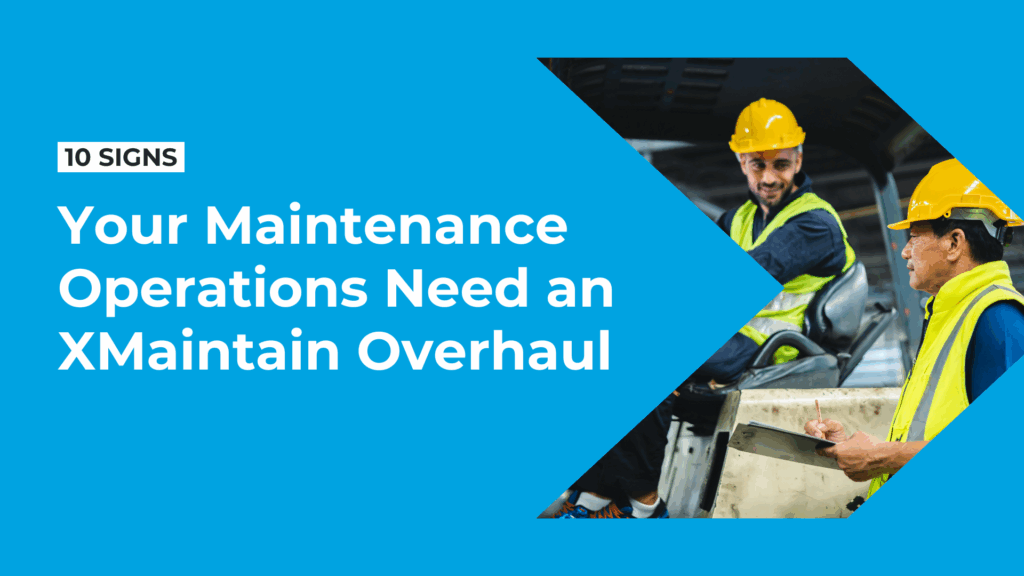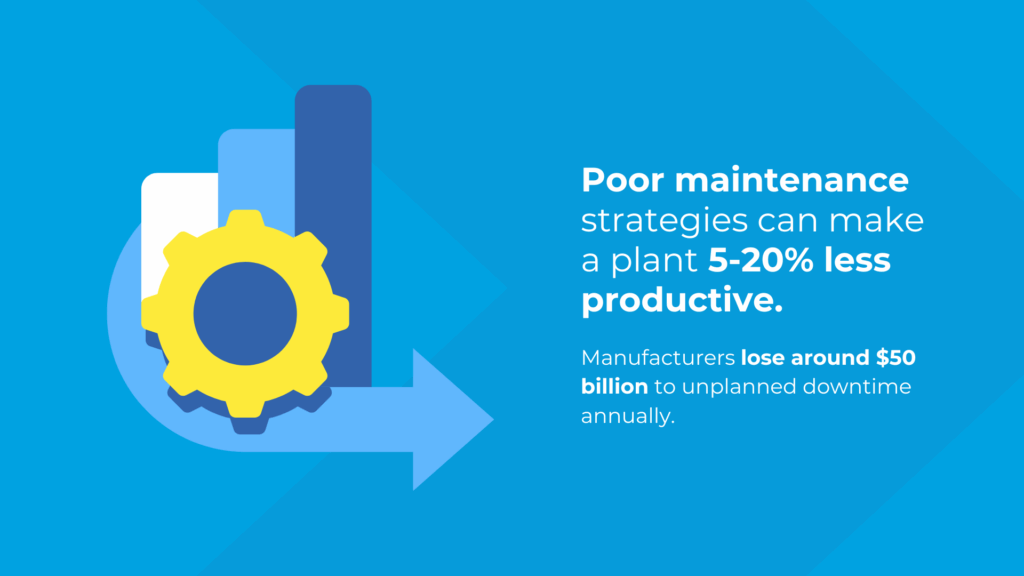10 Signs Your Maintenance Operations Need an XMaintain Overhaul

How to Identify Issues and Implement a Smarter Maintenance Strategy
According to Deloitte research1, poor maintenance strategies can reduce a plant’s productive capacity by 5 to 20 percent. This is a massive blow to efficiency, profitability, and customer commitments.
Yet, many companies struggle with outdated maintenance processes. This leads to unexpected downtime, rising costs, and inefficiencies that impact the bottom line.
If any of these 10 signs sound familiar, it may be time for a modern maintenance overhaul. Let’s explore the biggest red flags—and how XMaintain’s Computerized Maintenance Management System (CMMS) can help you take control of your maintenance operations.
1. Frequent Equipment Downtime
Unexpected breakdowns lead to production halts, delayed shipments, and unhappy customers. Maintenance teams scramble to diagnose issues, wait for replacement parts, and manually update logs, resulting in:
- Lost productivity
- Costly emergency fixes
- Higher risk of equipment damage
Snowballing Issues
Reactive maintenance leaves teams playing catch-up without a system for tracking failure patterns and asset health. Minor issues go unnoticed until they escalate into major failures, costly repairs, and prolonged downtime.
Proactive Control
Modern CMMS software like XMaintain enables proactive maintenance, helping teams prevent failures before they disrupt operations.
- Schedules preventive maintenance when equipment reaches predefined thresholds.
- Tracks asset history to uncover recurring failure patterns.
- Provides real-time alerts so teams can act before breakdowns occur.
Research shows that preventive maintenance strategies can reduce equipment downtime from 800 hours per month to less than 100. That is a game-changer for operational efficiency
2. Lack of Real-Time Visibility into Maintenance Metrics
Without real-time maintenance data, teams rely on outdated reports. This can lead to delayed response times, inaccurate tracking, and compliance risks.
Without instant insights, it’s hard to answer critical questions:
- Which machines are at risk of failure?
- Are maintenance tasks being completed on time?
Flawed and Fragmented Data
Spreadsheets and disconnected systems make real-time maintenance tracking impossible. By the time teams notice an issue, it’s already too late to prevent costly failures.
Precise Decision-Making
With a centralized CMMS, teams can monitor KPIs and asset health in real-time—allowing for faster, data-driven decisions.
- Live dashboards keep teams informed constantly.
- Automated reports eliminate manual data entry errors.
- Real-time work order tracking improves
XMaintain eliminates blindspots, giving companies complete visibility into maintenance performance and improving response times by up to 30 percent.
3. Maintenance Data is Siloed Across Departments
When maintenance, production, and inventory teams operate in silos, communication breaks down. Duplicate orders, scheduling conflicts, and unnoticed failures wreak havoc.
Isolation and Miscommunication
Many companies rely on separate systems for maintenance, procurement, and operations. Without a centralized platform, teams spend more time chasing updates than preventing failures.
Shared Maintenance Insights
XMaintain consolidates data, eliminating silos between teams. It streamlines coordination, prevents duplicate work, and improves efficiency.
- A unified maintenance hub ensures that all departments access the same data.
- Cross-department collaboration eliminates miscommunication.
- Real-time visibility into maintenance needs ensures smooth operations.
Connecting maintenance teams with real-time data prevents costly misalignment and improves efficiency and uptime.

4. Reactive Maintenance Dominates Operations
If your team is constantly fixing breakdowns instead of preventing them, you’re stuck in reactive mode—resulting in higher repair costs, unplanned downtime, and shorter equipment lifespans.
Unplanned Breakdowns
Without a preventive maintenance strategy, minor issues can escalate into major failures. Many companies rely on run-to-failure approaches, which cost three to five times more than planned maintenance.
Averting Disruption
A CMMS like XMaintain shifts maintenance from reactive to proactive, reducing emergency repairs.
- Schedules preventive maintenance before failures occur.
- Monitors asset health trends to detect early warning signs.
- Boosts uptime with proactive planning.
Studies show that planned maintenance increases uptime by 10 to 20 percent, making operations far more predictable and efficient.
5. Difficulty Managing and Tracking Maintenance Documents
Missing or outdated maintenance records lead to compliance risks, inefficiencies, and wasted time. Delays increase when technicians can’t access maintenance documents, and audits become a nightmare.
Scattered Records and Compliance Gaps
Many companies still use paper-based records or fragmented digital files, making document retrieval slow and unreliable. It leads to missed safety inspections, compliance violations, and costly penalties.
Organized, Searchable, and Always Available
XMaintain’s built-in document management centralizes all records, from maintenance logs to inspection reports and compliance documents.
- Digitizes and organizes all maintenance records in one place.
- Provides instant retrieval for audits and regulatory compliance.
- Links documents to assets, allowing technicians immediate mobile access.
With centralized document management, businesses reduce retrieval time by 40 percent and streamline audits—avoiding regulatory surprises.
6. No Standardized KPIs or Custom Metrics
Without clear, measurable KPIs, accurately tracking maintenance performance is impossible. Teams often perform unnecessary maintenance or miss critical repairs, wasting resources and causing unexpected failures.
Poor Insights and Wasted Resources
Many companies rely on generic maintenance metrics that don’t reflect their actual needs. Others lack a standardized tracking system, causing data inconsistencies across teams and locations.
Smarter Decisions, Measurable Results
With XMaintain, businesses can define and track custom KPIs, aligning maintenance strategies with operational goals.
- Custom KPI tracking tailored to business goals.
- Automated reports provide real-time performance insights.
- Standardized benchmarking ensures smarter resource allocation.
Businesses can cut unnecessary maintenance costs by 5 to 10 percent by defining and tracking the correct maintenance KPIs.
7. Struggles with Multi-Site Maintenance Management
Managing maintenance across multiple locations is a logistical challenge. Inconsistent processes, lack of visibility, and disconnected data lead to delays, duplicated work, and higher costs.
Disjointed Systems and Operational Chaos
Many companies use separate systems for each site. This complicates tracking asset health, maintenance schedules, and spare parts availability across locations.
Seamless Centralized Oversight
A CMMS designed for multi-site management ensures complete visibility into maintenance activities across locations.
- A unified multi-site dashboard provides real-time maintenance tracking.
- Standardized workflows eliminate process inconsistencies.
- Cross-site reporting allows leaders to compare performance and optimize resources.
With centralized data on the XMaintain platform, maintenance leaders have the tools to streamline operations across all locations.
8. Poor Integration with Existing IT Systems
When maintenance software doesn’t integrate with ERP, inventory, or production systems, it creates data silos, scheduling conflicts, and missed service deadlines. The result? Delays, miscommunication, and higher operational costs.
Scheduling and Inventory Gaps
Legacy CMMS systems lack integration capabilities, forcing companies to update maintenance data across departments manually. This flaw causes inventory shortages, duplicate data entry, and inefficient scheduling.
One Connected System
XMaintain merges with existing systems to track assets in real-time, eliminating manual updates and scheduling conflicts.
- Syncs seamlessly with ERP, inventory, and procurement platforms.
- Automates data flow, eliminating manual work and reducing errors.
- Custom API support ensures compatibility with existing IT infrastructure.
Studies reveal that businesses can reduce administrative workload by 25 percent by connecting maintenance software with core IT systems.
9. Outdated or Inflexible Software
Maintenance software becomes a bottleneck when it can’t adapt or integrate with evolving business needs. Outdated CMMS systems slow teams down, limit reporting capabilities, and create inefficiencies.
Legacy Limitations
Many companies use legacy maintenance software without customization options, mobile access, or cloud capabilities. These limitations restrict growth, frustrate users, and force teams to work around system constraints.
Future-Proof, Scalable Maintenance
A cloud-based CMMS supports growing maintenance demands while ensuring seamless user adoption.
- Customizable workflows tailored to business needs.
- Scalable cloud platform that grows with your operations.
- Modern UI and intuitive navigation to improve efficiency.
Switching to a modern, flexible CMMS allows businesses to streamline reporting, enhance collaboration, and increase productivity by up to 20 percent.
10. Limited Mobile and Remote Access
When technicians can’t update or access maintenance data in the field, it leads to delays, miscommunication, and incomplete records. Work slows down, and urgent issues take longer to resolve.
Delayed Updates
Many maintenance systems lack mobile capabilities or require internet access, making it difficult for field teams to log updates or retrieve critical asset information on the go.
Always-On Remote Access
A CMMS with mobile access allows technicians to update work orders instantly, capture asset data, and complete tasks efficiently—whether online or offline.
- Offline functionality enables real-time updates even without internet access.
- A technician-friendly interface simplifies mobile work order management.
- Photo uploads improve reporting accuracy and speed.
Businesses using mobile CMMS solutions can reduce response times by 35 percent, ensuring faster issue resolution and smoother operations.
Your Maintenance Strategy Needs an Overhaul—Here’s What to Do Next
Unplanned downtime costs manufacturers an estimated $50 billion annually—a staggering expense many businesses don’t realize they can prevent.
If you recognize these warning signs, it’s time to upgrade to a smarter, more proactive maintenance approach. XMaintain helps you take control of your maintenance operations, eliminating inefficiencies and maximizing equipment uptime.
What XMaintain Delivers
- Automated Preventive Maintenance – Reduce equipment downtime and extend asset life with proactive scheduling.
- Real-Time KPI Tracking & Reports – Gain complete visibility into asset health and team performance.
- Centralized Multi-Site Management – Standardize maintenance processes across locations for seamless coordination.
- Seamless ERP & IT System Integration – Eliminate data silos and ensure smooth workflows between maintenance, inventory, and procurement teams.
- Flexible, Scalable CMMS – Future-proof your maintenance strategy with a cloud-based platform that adapts to your business needs.
- Mobile & Offline Access – Empower field technicians with instant access to work orders, reducing response times and improving accuracy.
With XMaintain, you’re not just fixing problems but preventing them. Make the switch today and unlock the full potential of your maintenance operations.
Ready to overhaul your maintenance strategy? Contact our team to see how XMaintain can transform your business.



